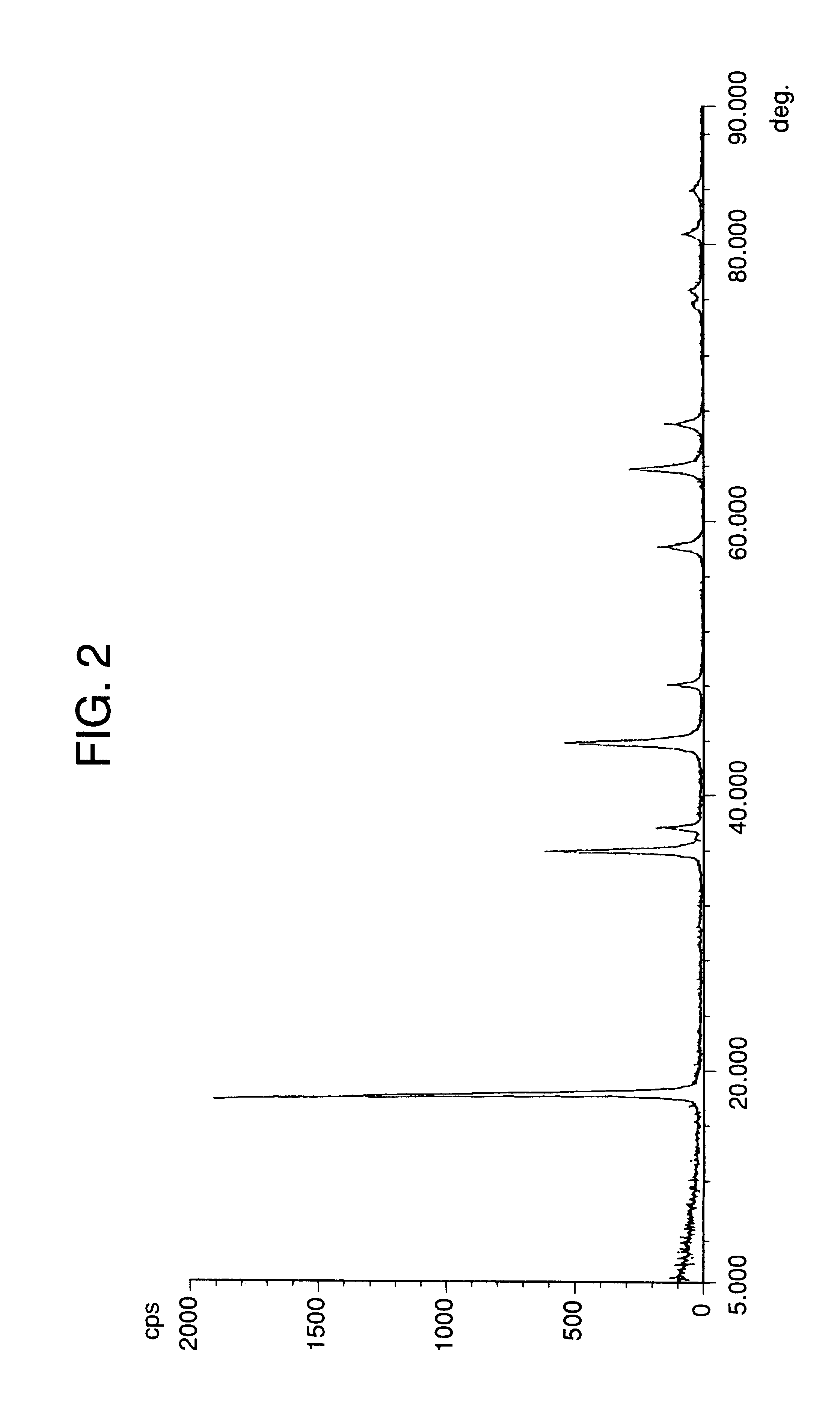Lithium manganate, method of producing the same, and lithium cell produced by the method
a lithium cell and manganate technology, applied in the direction of lithium compounds, manganates/permanentates, cell components, etc., can solve the problems of low difficult to obtain uniform composition, and inability to control particle size, etc., to achieve excellent cycle characteristics and high initial charge and discharge capacity
- Summary
- Abstract
- Description
- Claims
- Application Information
AI Technical Summary
Benefits of technology
Problems solved by technology
Method used
Image
Examples
example 1
(Synthesis of manganese hydroxide)
815 g of manganese sulfate (86% by weight as MnSO.sub.4) was dissolved in water to prepare 6.179 liters of a solution. This aqueous manganese sulfate solution was charged in a glass reaction vessel of 10 liters, and, with stirring, 2.321 liters of sodium hydroxide of 4 mols / l in concentration was added to and dispersed in the aqueous solution over a period of 1 hour in a nitrogen atmosphere with keeping the temperature at 15.+-.5.degree. C. to obtain a manganese hydroxide.
(Synthesis of manganese oxide)
The resulting slurry containing manganese hydroxide was heated to 60.degree. C., and air was blown thereinto for 1 hour to oxidize the manganese hydroxide in an aqueous medium, followed by aging for 1 hour with blowing nitrogen gas in place of the air and thereafter filtering and washing with water. The resulting filter cake was dried at 110.degree. C. for 12 hours to carry out gas phase oxidation to obtain a manganese oxide. This manganese oxide was l...
example 2
(Synthesis of manganese hydroxide)
A manganese hydroxide was obtained in the same manner as in Example 1.
(Synthesis of manganese oxide)
A manganese oxide was obtained in the same manner as in Example 1.
(Synthesis of lithium manganate precursor)
The resulting manganese oxide (240 g in terms of Mn) was dispersed in water to prepare a slurry. Pure water and 0.870 liter of lithium hydroxide of 3.206 mols / l in concentration were added to the slurry to obtain 2.40 liters of a liquid. This was charged in a glass reaction vessel of 3 liters and heated to 80.degree. C., and reaction was carried out for 3 hours with blowing air thereinto. The evaporated water was replenished and then a part of the slurry was taken, and alkali concentration thereof was measured to find that 16.4% by weight of the added lithium reacted with the manganese oxide. The slurry was charged in an autoclave and subjected to hydrothermal treatment at 150.degree. C. for 2 hours. The slurry was cooled to 80.degree. C. and th...
example 3
(Synthesis of manganese hydroxide)
A manganese hydroxide was obtained in the same manner as in Example 1.
(Synthesis of mangane se oxide)
A manganese oxide was obtained in the same manner as in Example 1.
(Synthesis of lithium manganate precursor)
The resulting manganese oxide (186.5 g in terms of Mn) was dispersed in water to prepare a slurry. Pure water and 0.746 liter of lithium hydroxide of 3.000 mols / l in concentration were added to the slurry to obtain 2.40 liters of a liquid. This was charged in a glass reaction vessel of 3 liters and heated to 80.degree. C., and reaction was carried out for 3 hours with blowing air thereinto. The evaporated water was replenished and then a part of the slurry was taken, and alkali concentration thereof was measured to find that 13.8% by weight of the added lithium reacted with the manganese oxide. The slurry was charged in an autoclave and subjected to hydrothermal treatment at 180.degree. C. for 2 hours. The slurry was cooled to 80.degree. C. and...
PUM
 Login to View More
Login to View More Abstract
Description
Claims
Application Information
 Login to View More
Login to View More - R&D
- Intellectual Property
- Life Sciences
- Materials
- Tech Scout
- Unparalleled Data Quality
- Higher Quality Content
- 60% Fewer Hallucinations
Browse by: Latest US Patents, China's latest patents, Technical Efficacy Thesaurus, Application Domain, Technology Topic, Popular Technical Reports.
© 2025 PatSnap. All rights reserved.Legal|Privacy policy|Modern Slavery Act Transparency Statement|Sitemap|About US| Contact US: help@patsnap.com


